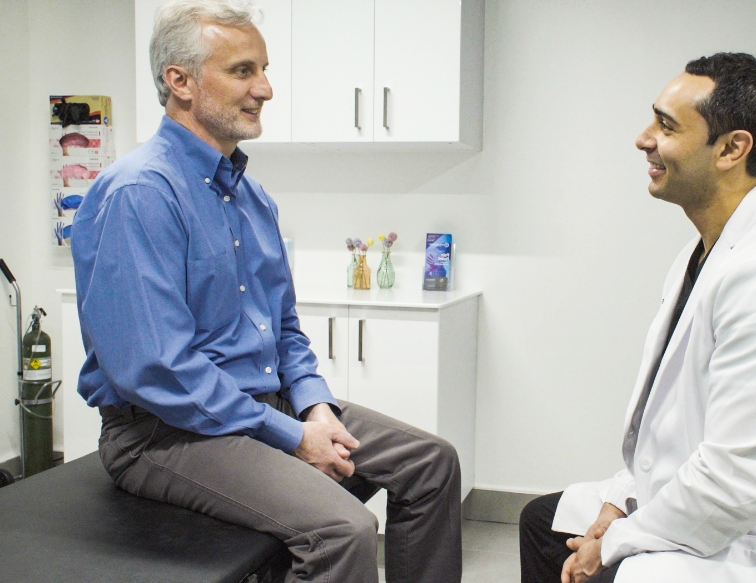Top Sciatica Pain Doctor in New York Answers 8 FAQs
February 04, 2021
1. What Is Sciatica?
Sciatica is incredibly common, affecting nearly 40% of adults at some point in their life. But it’s often misunderstood and lumped into the category of generalized back pain. Our renowned sciatica pain doctor in New York is here to eliminate the confusion by answering 8 common questions, including, what is sciatica?
As the name suggests, sciatic pain originates in the sciatic nerve, which is the largest peripheral nerve in the body, running from the lower back, through the buttocks, hips, and leg, into the foot. This nerve is formed in the lower lumbar spinal canal from lumbar and sacral nerve roots, and it sends signals from the spine to the lower extremities. Sciatic symptoms usually occur when this nerve is compressed somewhere along its path, causing radiating pain, burning, numbness, tingling, or weakness, often on one side of the body.

2. How Is Sciatica Different from Other Types of Back Pain?
One way this “back pain” differs from others, is that you might feel it more in your legs or buttocks than your actual spine. Some patients assume they have a problem with their hip joints or gluteal muscles, when it’s actually a peripheral nerve. Another key difference is that sciatica is not a disease, in and of itself, but the symptoms of an underlying problem. The issue could be a herniated disc or scoliosis, but the pain manifests when that problem exerts pressure on the sciatic nerve.
3. What Causes Sciatic Pain?
Many factors contribute to sciatic nerve pain, which is why consulting a sciatica specialist is key. Different causes require different treatments to fully eradicate the pain. As you’ll see below, it’s not just about dulling the pain. There is often an underlying issue that needs resolving. Take a look at some of the common causes and then schedule a consultation with Pain Treatment Specialists to determine your exact cause.

- Spinal stenosis (narrowing of the spine)
- Herniated disc
- Scoliosis
- Degenerative Disc Disease
- Spondylolisthesis
- Bone Spurs
- Ankylosing Spondylitis
- Sacroiliac joint irritation
- Fractures
- Cancerous tumors
4. What Are the Symptoms of Sciatica?
Symptoms vary by patient, but one tell-tale sign is the radiating nature of the sensations. Patients often describe it as a feeling that starts in the lower back or buttock and travels down through their leg. Here are some common ways our patients describe sciatic pain.
- Numbness or tingling that radiates through the buttock and leg
- Sharp pain when standing or walking
- Pain that’s primarily on one side of the posterior
- Burning sensation that runs down the leg
- Stabbing pain in the hip, buttock, or lower back
- Cramping in the thighs
- A feeling of pins and needles in the lower extremities
- Weakness in leg muscles inhibiting movement of feet or legs
5. What Are the Risk Factors for Sciatica Pain?
Anyone can develop these symptoms; keep in mind that 40% of adults will experience sciatica at some time or another. But there are steps you can take to lower your chances. Here are some risk factors to avoid when possible, although some are genetic or age-related.
- Heavy lifting, especially while twisting the spine (loading items on a truck)
- Being sedentary for long periods of time
- Frequently driving for several hours at a time
- Smoking
- Obesity or rapid weight gain
- Pregnancy
- Alcohol or drug abuse
- Sleep deprivation
- Anxiety, depression, tension in the spine
- Diabetes
- Arthritis
- Family history of sciatica
- Aging (After age 30, risk of herniated disc increases. After age 60, risk of spinal stenosis increases.)
6. Are There Any Home Remedies for Sciatic Pain?
Since sciatic nerve compression can result from numerous things, don’t try to treat it without consulting a sciatica specialist first. The best treatments for sciatica are performed by qualified doctors, and those are listed in the section below this one. But with your doctor’s approval, here are some supplemental things you can do at home to prevent sciatica from worsening.
- Exercise Often– Incorporate cardio, strength training, and flexibility exercises to keep your core and spine strong and reduce pressure on the nerves. Spinal health reduces the risk of fracture, herniation, and weakened muscles that contribute to sciatica. Remember to check with your doctor first to make sure your choice of exercise will help rather than exacerbate the pain.
- Don’t Sit for Too Long–If your job requires a lot of sitting, break up the monotony to reduce pressure on the sciatic nerve. Periodically stand up and walk around, or consider standing while on phone calls or talking to coworkers. Some patients like a standing desk, which can be purchased or constructed by placing the desk on risers or elevating your computer on your desk.
- Manage Your Weight–Even a little weight loss can take pressure off your spine, relieving sciatic pain and minimizing your risk of disc herniation. Set a small, achievable weight loss goal, and you’ll be surprised what a difference it makes.
- Stand or Sit Up Straight– You probably heard this as a child growing up, typically so that we’d look polite and alert, rather than slouched and disinterested around guests. But it’s actually a good tip to relieve sciatica too. Draw your shoulders back as if you wanted your shoulder blades to touch. And check to see if you’re bending over your computer keyboard, or if your upper back is touching your chair.
7. What Are the Best Sciatica Treatments?
The best treatment is highly dependent on what’s causing your pain. For some patients, sciatica is a short-term problem that resolves itself in a week or two. If you sustained an acute injury that compressed the nerve with temporary swelling, for instance, the sciatic pain will subside as you heal. But for other patients, sciatica is chronic or recurrent, particularly if you don’t treat the actual problem. Seeking an evaluation from a qualified sciatica doctor in NYC is important to determine the right course of treatment. Here are some of the minimally invasive, outpatient solutions Pain Treatment Specialists provides to relieve sciatica.
- Long-acting anesthetic injections
- Steroid injections
- Heat/Ice therapy
- Trigger point injections
- Lumbar facet injections
- Genicular nerve blocks
- Lumbar epidurals
- Steroid injections
- Sacroiliac joint injections
- Joint cooled radiofrequency
- Non-steroidal pain medicine
- Physical therapy
8. Who’s the Best Sciatica Pain Doctor in New York City?
Sciatic pain can be a real pest if you don’t get to the bottom of it. Patients who try to self-treat the problem are often frustrated when it recurs. Seek the expertise of the board-certified pain doctors at Pain Treatment Specialists in New York City, conveniently located near Grand Central Station. Our physicians conduct a comprehensive physical exam and use ultrasound scans, MRIs, and X-rays as needed to identify your unique causation. Our doctors are world-renowned for relieving sciatic pain gently, quickly, and completely.
Book a Consultation
Scheduling a consultation with one of our pain treatment specialists is one of the best ways to determine the proper solution for pain relief.














